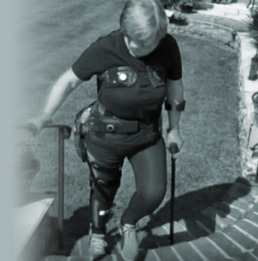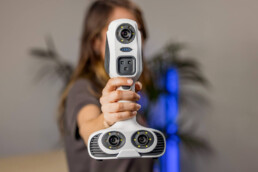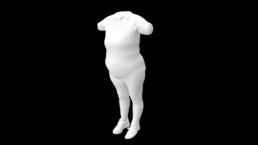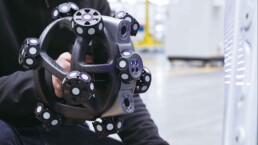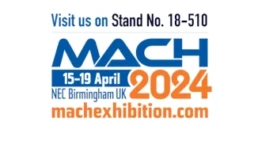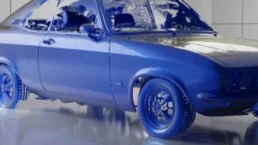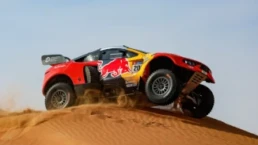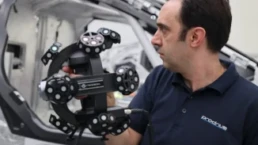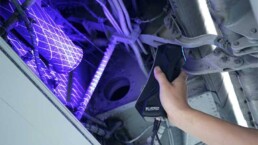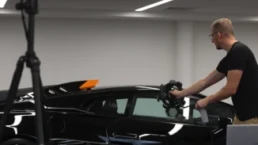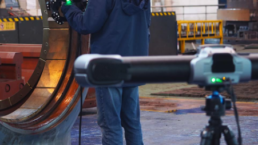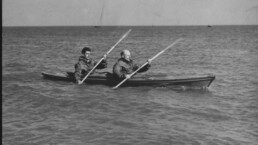‘Xothotics Ltd have created what we believe is the world’s first true full body weight offloading exoskeleton. This has the potential to transform the lives of many patients who are currently faced with a life in a wheelchair. It offers them the possibility of being able to stand and even walk, which is essential for not only their physical health but also their mental health’ – Paul, Chief Technology Officer, Xothotics Ltd.
Recently, The 3D Measurement Company Ltd (T3DMC) played a pivotal role in the creation of the world’s first weight offloading exoskeleton, acquiring vital 3D data for upstream development.
Exoskeletons are medical and industrial devices that are designed to support and enhance human movement. Exoskeletons have been used to help patients regain mobility and also augment human performance in industrial applications. To this day, exoskeletons are typically made from materials such as carbon fibre, metal or elastic and could be full-body or cover specific body parts like the hip, knee or elbow. However, with advances in 3D scanning technology, physical interfaces between the human user and robot can now be accurately mapped out for a closer fit while still providing comfort. This new level of precision has allowed medical professionals to develop more efficient and effective solutions for their patients.
The Xothotics exoskeleton was created by Paul, who developed a solution for his wife Jane, who was set to live the rest of her life in and out of a wheelchair and crutches after having an internal hemipelvectomy due to cancer. This was the only treatment available and resulted in the removal of her right pelvis to remove the diseased bone. After 4 years of rehabilitation of walking with two crutches, despite meeting with several manufacturer R&D departments it became clear that there was no existing solution so Paul started the design of a solution that meant Jane could walk using only one crutch.
The Design and Development
T3DMC conducted a 15 minute 3D body scan using the iReal 2E to acquire unique data of Jane’s body. This data was then used to create an accurate model of Jane’s body, which underpinned the design and development of the full brace to ensure an effective and comfortable fit.
‘Being able to rapidly and accurately perform a 3D scan which can quickly be converted to a solid model with a 5 axis CNC machine opens the possibilities for many more patients to cost effectively benefit from this system. Accurate 3D scanning is essential to helping us create accurate models of the human form which is critical for a precise and comfortable fit’ – Paul, Xothotics Ltd.
Bakers Patterns used the 3D scan data to make a CNC model in hard foam. After manual refinements to adapt the brace to Jane’s body, carbon fibre was overlaid onto the CNC model to build the supporting elements and was joined with kevlar hinges and custom 3D printed aluminium joints.
The complete exoskeleton is able to support Jane’s upper body weight and transfer her weight through a custom built multi joint hip hinge to a custom built leg orthosis, incorporating a sophisticated ankle joint interface with suspension. Now Jane is able to walk comfortably for hours with ease.
After many design refinements the complete exoskeleton was able to support Jane’s upper body weight and transfer weight through a custom built multi joint hip hinge to a customer built leg orthoses, incorporating a sophisticated ankle joint interface with suspension. Now Jane is able to work comfortably with ease.
‘Stairs, they were my nemesis but now I approach them with confidence. Standing was an activity I could only tolerate for about 10 minutes, now standing for hours is easy. And yet … It is still just a prototype. These are very early days on an exciting journey of development and discovery’ – Jane.
A Wider Solution In The Medical Industry
‘Xothotics have created what we believe is the world’s first true full body weight offloading exoskeleton. This has the potential to transform the lives of many patients who are currently faced with a life in a wheelchair. It offers them the possibility of being able to stand and even walk, which is essential for not only their physical health but also their mental health’ – Paul, Xothotics.
Discussions are currently taking place with leading medical professionals that believe there are a significant range of medical conditions which might benefit from this technology. However, this solution is not a one size fits all. For it to be successful it will require the capability to rapidly 3D scan the patient and to develop processes that can deliver individually customised solutions.
Other news articles
7th February 2024
Revving Up Innovation: T3DMC Becomes Prodrive’s Official 3D Scanning Partner
Explore how our 3D scanning partnership with Prodrive is accelerating advancements in motorsport and driving innovation.
29th August 2023
Preserving History With 3D Scanning Technology: The Mk2 Cockle Canoe, Operation Frankton
Preserving history with SIMSCAN. Capturing 3D data of WW2's unsung hero, Operation Frankton's Mk2 Cockle Canoe.

